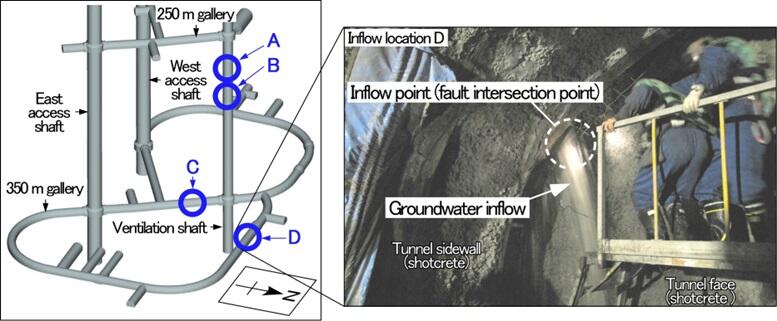Group leader Eiichi Ishii of the Sedimentary Rocks Safety Evaluation Research Group, the Horonobe Underground Research Laboratory, the Horonobe Underground Research Center in the Sector of Nuclear Fuel, Decommissioning and Waste Management Technology Department, at the Japan Atomic Energy Agency (JAEA) announced that his research group has clarified the mechanism by which the rate of water flow from faults in tunnel excavations is regulated. Based on simulation and observed data, they found that the flow rate of groundwater is slow when the connection of water paths on the fault plane is three-dimensional, whereas it is fast when the connection is close to one-dimensional. The findings are expected to be applied not only to geological disposal sites of radioactive waste but also to the prediction of measures, such as cement injection, needed when groundwater inflow occurs at tunnel construction sites. The results were published in the June 2023 issue of the international academic journal Hydrogeology Journal.

Provided by JAEA
When deep underground tunnels are being excavated, groundwater in the fault often flows into the tunnels. The water amount must be suppressed to prevent ground subsidence and to diminish the effects on the surrounding area. As a general countermeasure, cement is injected into the fault after ground boring, but this process costs tens of millions of yen or more. Since the amount of water decreases with time, this countermeasure can be postponed if the rate of decrease is fast. However, the mechanism of water flow decrease was so far unknown.
The research group investigated the rate of decrease in the groundwater amount from a fault encountered during the excavation work of the Horonobe underground research facility.
Analysis of the drilling survey conducted in advance revealed that the connection of the presumed water flow path in the fault was three-dimensional, and the flow rate was not reduced even after a month. By contrast, in the case of a one-dimensional fault, the flow rate decreased to a half to one tenth within a few days to weeks. The observed result was consistent with the simulation finding.
Ishii explained, "By using a permeability test in advance to estimate the water flow channel within the fault in the planned excavation area, we can make predictions about cement injection needs on the site according to the forecast. Even without prior permeability testing, we can predict the rate of decline of the water volume immediately after the occurrence of water inflow. We expect that these findings will improve the efficiency and economy of construction work."
Journal Information
Publication: Hydrogeology Journal
Title: Effects of flow dimension in faulted or fractured rock on natural reductions of inflow during excavation: a case study of the Horonobe Underground Research Laboratory site, Japan
DOI: 10.1007/s10040-023-02628-3
This article has been translated by JST with permission from The Science News Ltd. (https://sci-news.co.jp/). Unauthorized reproduction of the article and photographs is prohibited.




